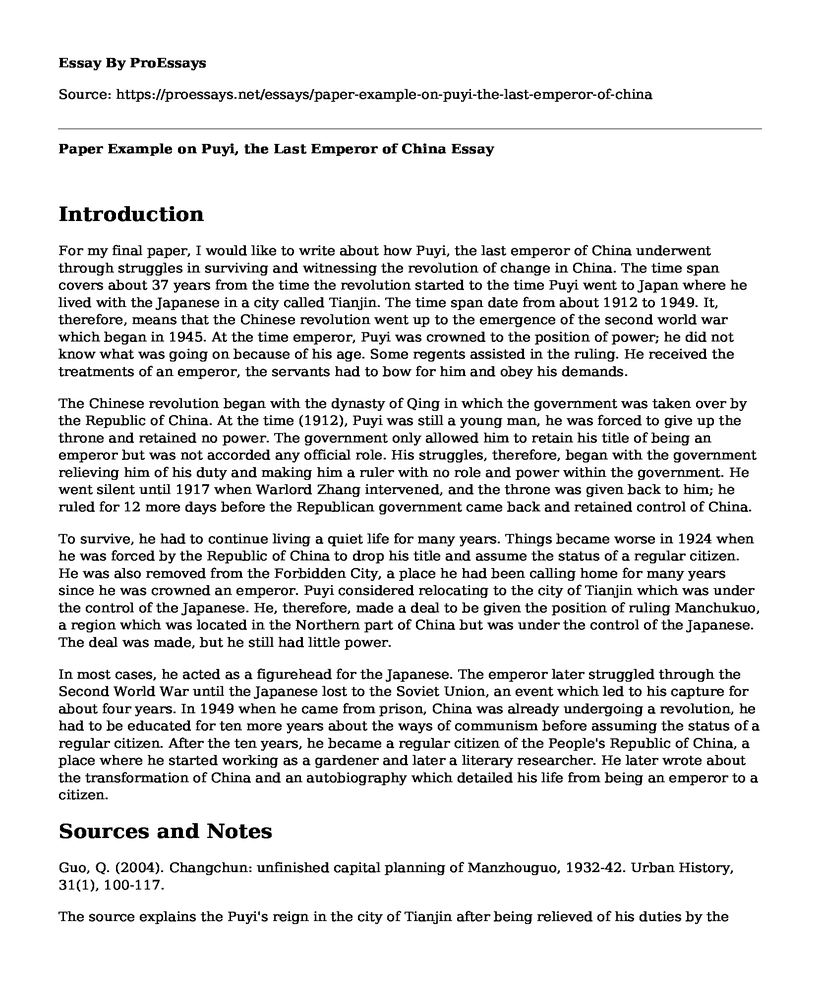Introduction
For my final paper, I would like to write about how Puyi, the last emperor of China underwent through struggles in surviving and witnessing the revolution of change in China. The time span covers about 37 years from the time the revolution started to the time Puyi went to Japan where he lived with the Japanese in a city called Tianjin. The time span date from about 1912 to 1949. It, therefore, means that the Chinese revolution went up to the emergence of the second world war which began in 1945. At the time emperor, Puyi was crowned to the position of power; he did not know what was going on because of his age. Some regents assisted in the ruling. He received the treatments of an emperor, the servants had to bow for him and obey his demands.
The Chinese revolution began with the dynasty of Qing in which the government was taken over by the Republic of China. At the time (1912), Puyi was still a young man, he was forced to give up the throne and retained no power. The government only allowed him to retain his title of being an emperor but was not accorded any official role. His struggles, therefore, began with the government relieving him of his duty and making him a ruler with no role and power within the government. He went silent until 1917 when Warlord Zhang intervened, and the throne was given back to him; he ruled for 12 more days before the Republican government came back and retained control of China.
To survive, he had to continue living a quiet life for many years. Things became worse in 1924 when he was forced by the Republic of China to drop his title and assume the status of a regular citizen. He was also removed from the Forbidden City, a place he had been calling home for many years since he was crowned an emperor. Puyi considered relocating to the city of Tianjin which was under the control of the Japanese. He, therefore, made a deal to be given the position of ruling Manchukuo, a region which was located in the Northern part of China but was under the control of the Japanese. The deal was made, but he still had little power.
In most cases, he acted as a figurehead for the Japanese. The emperor later struggled through the Second World War until the Japanese lost to the Soviet Union, an event which led to his capture for about four years. In 1949 when he came from prison, China was already undergoing a revolution, he had to be educated for ten more years about the ways of communism before assuming the status of a regular citizen. After the ten years, he became a regular citizen of the People's Republic of China, a place where he started working as a gardener and later a literary researcher. He later wrote about the transformation of China and an autobiography which detailed his life from being an emperor to a citizen.
Sources and Notes
Guo, Q. (2004). Changchun: unfinished capital planning of Manzhouguo, 1932-42. Urban History, 31(1), 100-117.
The source explains the Puyi's reign in the city of Tianjin after being relieved of his duties by the Republic of China.
Itoh, M. (2016). Manchurian Incident and the Long March. In The Making of China's War with Japan (pp. 85-111). Palgrave Macmillan, Singapore.
I will use the source in analyzing the Chinese war with Japan. A struggle which advanced the sufferings of Puyi.
Yizhuang, D., & Elliott, M. (2018). How to write Chinese history in the twenty-first century: The impact of the "New Qing History" studies and Chinese responses. Chinese Studies in History, 51(1), 70-95.
I will use the source to trace Chinese history based on the impact of the New Qing history studies. It also documents the Chinese struggle between the 20th and 21st century.
Larry, D. (2015). China's Civil War: A Social History, 1945-1949. Cambridge University Press.
I will use the source because it documents the Chinese civil war which took place between 1945 and 1949. The source also documents the struggle of Puyi in retaining power even as the Republic of China was adamant to allow him to have control of their land.
Tsang, K. B. (2017). In Her Majesty's service: women painters in China at the court of the Empress Dowager Cixi. In Local/Global (pp. 51-74). Routledge.
I will use the source to learn about the services which were being offered to emperor Puyi even when he was a younger age and to also understand how he later became a civilian.
Thesis
China went through a series of transformation in the 20th century following the power struggle between emperor Puyi and the government of the Republic of China. The paper is, therefore, premised on a thesis which seeks to determine how Puyi, the last emperor of China struggled and witnessed revolution change in China.
Cite this page
Paper Example on Puyi, the Last Emperor of China. (2022, Aug 10). Retrieved from https://proessays.net/essays/paper-example-on-puyi-the-last-emperor-of-china
If you are the original author of this essay and no longer wish to have it published on the ProEssays website, please click below to request its removal:
- Korean and Vietnam Wars Comparative Essay Example
- Final Word on Legal Decisions: Supreme Court's Vital Role - Essay Sample
- US Military Use of IMINT Visual Photography Sensors: A Case Study
- Essay Sample on Michigan State: A Region of Achievements, Failure, and Calamity
- Free Essay Sample on Fossil Fuels: The Non-Renewable Energy Source
- 1960s Unrest Repeats Itself: Protests, Wars, Turmoil Today - Essay Example
- Essay Sample on Civil War







